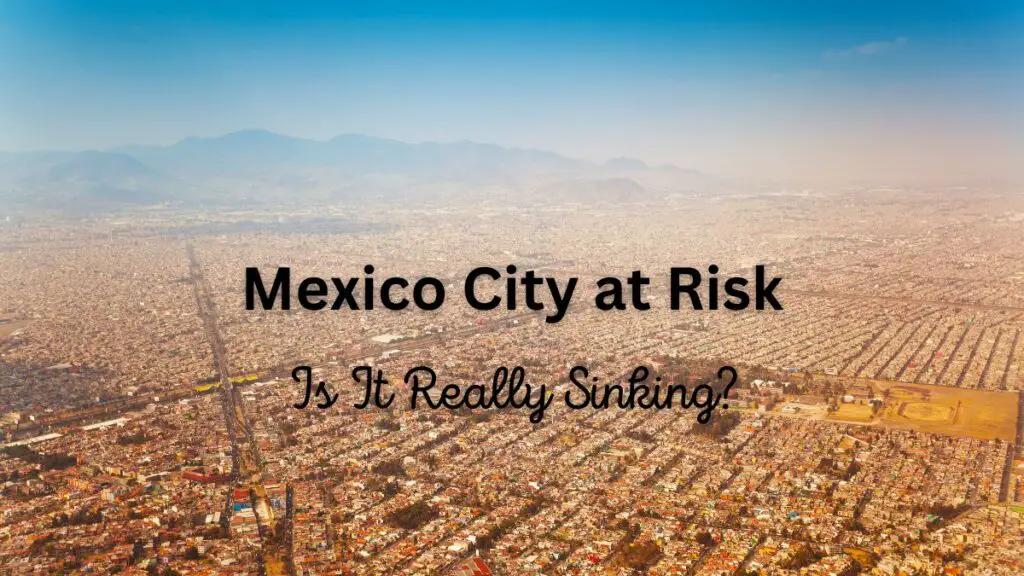One of the many amazing facts you may have encountered when searching about Mexico City is the statement that says the entire city is sinking. Honestly, it sounds more interesting rather than amazing. Nonetheless, it will make you wonder if the city is really sinking.
Mexico City is sinking, and experts say it’s because of the phenomenon known as subsidence. As of the moment, it sinks rapidly and has already sunk for several feet since the beginning of the 20th century.
While it may sound fascinating to tourists and travelers interested in visiting the city, it’s a crisis to the local and national governments since it’s caused by the city’s water supply and demand. If you want to know more details, this article is for you.
Here, we’ll give you an in-depth take on the sinking problem of Mexico City. This information includes the cause of the sinking and the rate of the sinking each year. It will also give you an idea about another fact you may find interesting whether you’re visiting the city or not.
Without further ado, let’s get into it!

Is Mexico City Sinking?
Mexico City is sinking, and it’s a fact proven by many experts. According to a study, Mexico City, the capital of Mexico, has already sunk nine to eleven meters deep since the start of the 20th century.
There is a phenomenon known as subsidence that is compacting the metropolis’s landscape, and parts of it are now dropping about a foot and a half and a half a year.
Dry lake beds, thirsty populations, poor water conservation, earthquakes, and seismically active ground pose serious combined problems.
If the problem is not addressed soon, the metropolis of approximately 24 million (proliferating) will be threatened with infrastructure problems, water shortages, and irreplaceable architectural structures.
While it may seem odd for a city to sink, you’ll understand it better once you know the city’s beginning.
Mexico City Before It Started Sinking
To understand this sinking problem, you need to note that Mexico City was originally a small island in the center of a lake, Lake Texcoco.
The Aztecs inhabited the city in ancient times, and as the city flourished, they created artificial islands and developed a canal system.
From then on, the mainland and artificial islands got connected through causeways. As of now, these paths have become the city’s main roads.
In the 1500s, Spain conquered the city, destroyed the Aztec structures, and built new ones. The result of these massive changes drained the lake, although a small portion still exists today near the city.
Since the water demands of the city’s residents come from the lake, the continuous extraction through aquifers significantly contributed to the deterioration of the entire city’s base, causing the sinking.
Why Is Mexico City Sinking?
As mentioned earlier, the city continues to sink because of a geological problem known as subsidence. Such an event usually occurs when soil is compacted due to the withdrawal of too much water from underground.
Since the city gets its waters underground, the water from the former lake grows less significant over time. Also, the water demand grows higher each year since the city is the most populated one in the country.
For this reason, the sinking rate increases as well every year, and it’s something that can cause significant problems when unresolved soon.
What Is the Primary Cause of This Problem?
The sinking problem of Mexico City is due to several factors, but the main problem is the draining of the lake underneath.
As mentioned earlier, the entire area of Mexico City lies on top of an underground lake whose water is being drained by the city’s continuous population growth.
It is estimated that 70% of the lake’s resources are used to provide water for drinking, bathing, and other use. With such consumption and demand, the lake’s water continues to get drained, causing the soil above (the mainland) to compact and sink.
Contrary to what is observed in several other cities worldwide, Mexico City’s sinking does not appear to correspond to regional groundwater pumping levels. Instead, it shows how the city’s foundation was gradually compacted into the original lake bed.
Tenochtitlán, an Aztec metropolis, was situated on the shores of what is now Lake Texcoco. The 100-meter-thick, saline, clay-rich lake floor was left dry when water extraction pushed groundwater farther down.
Since then, the ground has gradually contracted and subsided due to its fragile mineral grains repacking themselves more firmly.
According to the experts, this type of compaction is permanent and causes significant cracks that harm municipal infrastructure, such as sewers, gas and water lines, buildings, and historical landmarks.
Besides exposing the ground to tainted surface waters, the fracture might make it much harder for city residents to acquire clean water.
How Fast Is Mexico City Sinking?
The sinking rate of Mexico City continues to grow every year. As of the moment, the rate is around 20 inches or 50 centimeters every year. What’s worse is that the sinking doesn’t stop and will gradually increase when the water demand continues to grow.
Experts have determined that large areas of the earth underneath the city are progressively compacting after being long since drained of water.
This conclusion was reached by merging more than a hundred years of ground-based data with twenty-four years of space-based studies.
They predict that the surface will continue to compress for roughly 150 years, adding up to 30 meters to the several meters of subsidence that have already occurred throughout the 20th century.
Conclusion
Mexico City is actually at risk, and it’s because of its sinking problem. The entire city rests on a top of a lake, and the water continues to drop since it’s the primary source of the city’s water demand.
As such, it’s something that needs resolution soon. Otherwise, the city can suffer from significant problems regarding its base, and it can cause other problems such as water contamination, drought, and other devastating calamities.
If you want more facts about the city, read other Amazing Facts About Mexico City.



